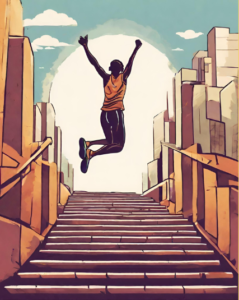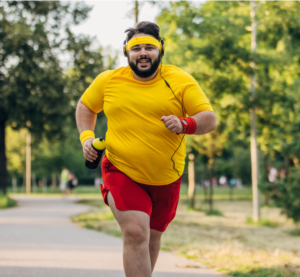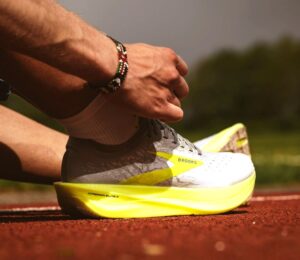Expert Advice on Treating Achilles Tendinopathy
What is Achilles Tendinopathy?
 Heel pain, or what is most commonly diagnosed and known as Achilles Tendinopathy, affects the back of one or both heels. The Achilles tendon is one of the strongest tendons in the body. It can absorb your whole weight being applied through it and then reuses that weight to push you on to your next step, like a spring.
Heel pain, or what is most commonly diagnosed and known as Achilles Tendinopathy, affects the back of one or both heels. The Achilles tendon is one of the strongest tendons in the body. It can absorb your whole weight being applied through it and then reuses that weight to push you on to your next step, like a spring.
The Achilles tendon attaches to the back of the heel bone (calcaneum) and is also attached to the calve muscles which helps move the tendon and points your foot downwards.
When things go wrong, see ‘The Cause’ below, it can result in the Achilles tendon changing in shape (some people notice a lump on it), and becoming swollen and inflamed. People who suffer from pain in the back of their heel, quite often find it hard to stand up when they have been sitting down for periods of time or can feel pain after they have been training/playing their sports. Types of movements which can aggravate the pain are running & jumping.
The Cause
 There are many different causes of pain in the back of the heel which can be an Achilles tendinopathy. Some of these factors can be related to lifestyle and medical conditions. Below are some of the examples which may be the cause of Achilles tendinopathy.
There are many different causes of pain in the back of the heel which can be an Achilles tendinopathy. Some of these factors can be related to lifestyle and medical conditions. Below are some of the examples which may be the cause of Achilles tendinopathy.
- Sudden increase in level of exercise / activity – If you are not an active person and suddenly increase your walking, start to run, or start going to a lot of fitness classes in a short period of time, your muscles and tendons are not able to cope with this big increase and this can often lead to the development of heel pain like Achilles tendinopathy.
- Being overweight – This causes more pressure to be applied through the heel as this is the first part of your foot to contact the ground when walking and most of the time when you run (some people contact the ground with the middle of their foot or front of their foot when running)
- Middle age – As we get older our muscles and collagen changes which results in them not being as strong as they once were. This means that more pressure is placed through the heel.
- High arches – Having high arched feet can also lead to people having heel pain. Quite often, people with high arches have a higher load placed through their heel as their foot may not pronate enough to absorb the pressure being applied from the ground and body. They can also have more ankle and calf muscle stiffness which can lead to an increase in pressure through the heel.
- Medical conditions – Being a diabetic or having other conditions such as Rheumatoid Arthritis or systemic conditions, can be the cause of heel pain. If you have diabetes and your blood sugars are high (more than 7mmol/L) for a long time, this can change the structure of the cells that make up your muscles and tendons leading to pain in the heel. If your Rheumatoid markers have changed, this can also lead to the development of heel pain.
- Medications – Certain medications have side effects which can also be the cause of heel pain such as cholesterol medication or antibiotics (fluoroquinolones – ciprofloxacin, norfloxacin & moxifloxacin). If you have recently been taking one of these medications, you should consult your GP to see if another medication can be prescribed without these side effects.
Now that you know some of the factors that can lead to the cause of Achilles tendinopathy, you can see how you may be able to make some changes to prevent heel pain developing. If you aren’t sure read on to the next section ‘How to prevent heel pain’ and ‘How to self-manage you heel pain’.
How to prevent heel pain
 There are many ways in which you can try to prevent heel pain and mitigate the causes. The list below on how to prevent Achilles Tendinopathy is not exhaustive but can be a good place to start. Be aware that sometimes there is more than 1 factor that can help, these include:
There are many ways in which you can try to prevent heel pain and mitigate the causes. The list below on how to prevent Achilles Tendinopathy is not exhaustive but can be a good place to start. Be aware that sometimes there is more than 1 factor that can help, these include:
- Losing weight – By losing weight, we reduce the pressure being applied through our feet. This can be done through diet and exercise.
- Gradual increase in exercise – If you have always been a person who does not exercise, you are looking to be more active, or training for a marathon, it is important that it is done gradually. By taking gradual increase in exercise (i.e. Two 30 minute walks a week for 2 weeks, then increase it to 3 walks and so on) it allows the muscles and tednons to become stronger at a rate at which they can adapt to, which should minimise the development of heel pain.
- Footwear – Wearing the correct footwear is very important, not only does this help with your choice of exercise, it will also help prevent heel pain. Things you should be looking for in a good shoe are a firm heel counter (the back of the shoe doesn’t fold down), lace up or Velcro, firm midsole (shoe can’t fold in half) and a toe spring (the front of the shoe bends up). You also want to avoid wearing shoes which are flat when you are exercising. Having your feet measured for length and width is also very important. There are many different brands of footwear and within those brands they have different ones for support or high arched feet. If you are not sure what type of footwear would suit you best, feel free to book an appointment to discuss this further.
- Rest/Recovery – Making sure you have at least a day off after exercising is important to help prevent heel pain. By giving your muscles and tendons time to rest and recover, this allows them to be ready for the next time you train/exercise. If you were to exercise every day, this would result in a big increase in muscle/tendon use and eventually the cells that make up the muscles and tendons will begin to fail and break down causing pain.
- Sleep – Sleep is a massive part in injury prevention in which it has been found that not having enough sleep (7-8 hours) can dramatically increase your likelihood of developing heel pain. The quality of your sleep is also important.
- Dealing with stress – Modern life is very busy and can also be stressful. Stress along with other mental health issues such as anxiety, can lead to the development of heel pain. It is important that if you are experiencing stress or other mental health issues you should speak to you GP or a psychologist / counsellor to help you deal with this which over time.
- Medical conditions – Making sure if you are diabetic that you monitor your blood sugar levels and make sure that they do not sit above 7mmol/L for a long period of time. If you are struggling with controlling your diabetes, making an appointment to see your GP, endocrinologist or Diabetes Educator is very important and will help finds ways of stabilising your blood sugars.
- Strength – By adding in strength exercises, i.e. weights or body weight exercises, to your weekly routine it has been found to help your muscles and tendons cope with increased levels of activity. If you are a runner and do not have any strength sessions planned into your schedule, you really need to add a lower leg strength session as this can help prevent heel pain but has also been found to improve performance. If you are not sure what a strength session would look like, please feel free to use the book now button to make an appointment for us to help you with this.
How to self-manage your heel pain
Now that we know what the Achilles tendon is, what is an Achilles Tendinopathy, the causes and ways to prevent it, it is time to discuss the means in which you can help manage your heel pain.
You should check your footwear and change them if you notice they are worn on the outsole or are not providing you with support like they used to.
 Applying an ice pack to your heel for 5-10 minutes, three times a day will also help manage any localised inflammation that may be present in your heel. Remember to wear a sock on your foot when applying the ice to prevent a cold burn. *if you have neuropathy (where there is no feeling) you should avoid doing this until you have spoken to your health care practitioner.
Applying an ice pack to your heel for 5-10 minutes, three times a day will also help manage any localised inflammation that may be present in your heel. Remember to wear a sock on your foot when applying the ice to prevent a cold burn. *if you have neuropathy (where there is no feeling) you should avoid doing this until you have spoken to your health care practitioner.
Strapping your foot or heel can also help. Click on this link (how to strap the Achilles tendon) which shows you how to strap your foot by yourself.
Foam rolling your calf muscles will also help reduce the pressure on your heel and can help manage your heel pain. You should aim to roll your muscles for 5 minutes twice a day.
When It Might Not Be Achilles Tendinopathy
If you've been treating your Achilles tendinopathy but haven’t noticed much improvement — or if you're not quite sure it's actually your Achilles tendon causing the pain — there could be other conditions worth investigating.
Some injuries closely mimic the symptoms of Achilles tendinopathy, and it’s important not to overlook them:
-
Flexor Hallucis Longus (FHL) Tendinopathy – This tendon runs close to the Achilles and can produce similar pain, especially with pushing off or toe-related movements.
-
Plantaris Tendinopathy – The plantaris tendon runs alongside the Achilles and can cause deep, aching pain in the back of the ankle or calf.
-
Sural Nerve Irritation – The sural nerve runs just beside the Achilles tendon and, if irritated, can produce sharp, burning, or shooting pain.
If any of these sound like they could be relevant to you, it’s worth discussing further with a podiatrist. For a deeper look into one of these commonly missed conditions, read my blog on Flexor Hallucis Longus Tendinopathy and how it differs from Achilles-related injuries.
What if there is no improvement in the pain or I’m not sure if it is Achilles Tendinopathy?
At Sports & Injury Management, we work with athletes and weekend warriors, who are struggling with persistent, stubborn, niggling injuries, and work together on a specific treatment plan to help fix this pain.
This allows those athletes and warriors to become stronger, return to exercising, training, participating in sports and live pain free.
While recovery takes time and dedication you shouldn't put up with ongoing pain. If you have tried everything and are still not seeing results, your Diamond Creek Podiatrist can provide expert care. Call now or book online to take the next step toward pain-free movement.
With over 16 years as a Podiatrist, I have successfully treated lots of patients with this and similar conditions. Come and join our community of active happy people.
SIM – Getting stronger, staying active
